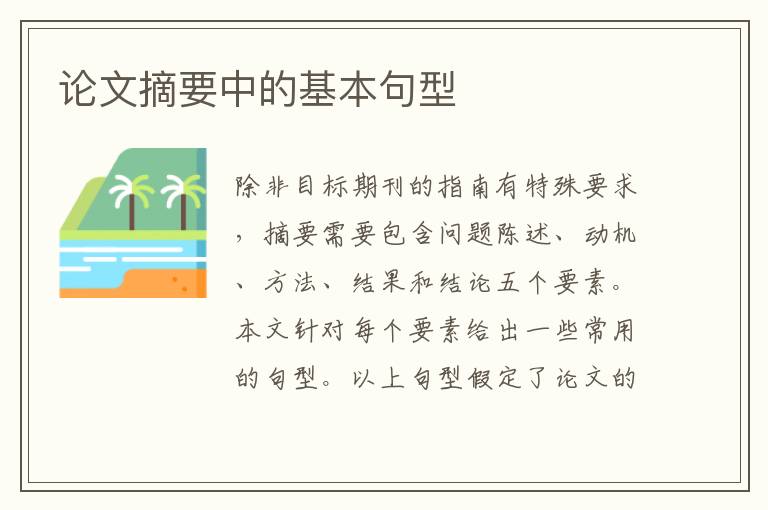论文摘要中的基本句型

内容提要
除非目标期刊的指南有特殊要求,摘要需要包含问题陈述、动机、方法、结果和结论五个要素。本文针对每个要素给出一些常用的句型。
句型举例中, A代表作者, C代表特征,D代表领域或方向,E代表某个解释或定义, M代表方法,P代表问题, R代表原因,X代表现象、规律等,O代表其他。对应的小写字母则代表子类或细分,例如,d代表D中的细分方向。摘要举例取自于文献【1】。
【1】EW.,CT.,SL.,CE.&TW.Life,nal,878:19(9pp),pp:1-9
01
问题陈述常见句型
陈述要解决的问题是什么,这个问题有什么地位或重要性。对于受益面比较大的问题,先用通俗易懂的语言陈述所有科学家都懂的部分,再陈述同行科学家才懂的部分。对于只面向同行科学家的论文,如果论文的标题和摘要中指出的动机很明显地带出了是什么问题,那么可以忽略这个要素。
问题陈述常见句型
a.Xis as E,and this is for (or key ) D. has been P, the p (or not , or not ). ( ) in d.
b.cdue to the of the of this in D. ,the p of P is (or not ) due to the lack of (or to or for of) R.
c.pis an in P and a key role in d.
d.R is the of X in p.
e. the most used and
f.X is a well- by C.
g.The of p in Phas of its in D.
h.pis an inD.
举例:
The zone (HZ) is of from a host star ,a key for life, may on a ’s . more CO2 than in ’s is to for most of the HZ, with bars at the . , most life on is by CO2 of just of a bar. same time, most in the HZ in to M , are more Sun-like G but are to of that can be in of , such as (CO).
可居住区(HZ)通常被定义为作为生命的一个关键要素的液态水可以存在于行星表面的离宿主恒星的距离范围。对于大多数可居住区,为了维持温和的温度,要求二氧化碳比地球现代大气中的二氧化碳多得多, 且在外边缘有几个巴的气压。然而,地球上最复杂的有氧生命受几分之一巴二氧化碳浓度的限制。与此同时,位于传统宜居带的大多数系外行星都位于M矮星附近,这种矮星比类太阳的G矮星数量更多,但据预测这会使在轨行星大气中更富有一氧化碳等有毒气体。
02
动机常见句型
动机用于指出论文要解决的具体问题是什么,必要时指出目的,适当指出解决这个问题的重要性和困难。
动机常见句型
a.Here we show (or )that X.
b.This aims to R of X in p.
c.The main /goal/ of the / a M (or he of X).
d.Here (or in this ) we (or or ) p (or X or M).
e.p (or X or M)is in this .
f.This is with p(orX or M).
g.The /(or with, , , , , a for, aims on, a to) p(orX or M).
h.This M ( M, M, X, R, on R)
i.This (or aims to give ) a of R.
j.This a M inp of P.
举例:
Here we show that the HZ for is to that for life.
在这里,我们指明,相对于微生物生命,适应于复杂有氧生命的宜居带(数目)可能受限。
03
方法常见句型
简述论文所采用的研究方法。对于读者所不熟悉的方法,应指出方法的特征和方法的来源。
方法常见句型
a.We Mfor pand this has the of C.
b.Mis used in this .
c. M ( or or case or or ) are with
d.To p (or to X),a onm here and this is of .
e. and this is of mto the ( ).
举例:
We use a 1D - and to a Zone for Life (HZCL) on for a as a of ..
我们使用1D辐射对流气候和光化学模型,根据一系列生物的已知毒性极限,划定复杂生命可居住区,以作为(我们提出的)概念的证明。
04
结果常见句型
呈现论文得到的最重要/主要的结果。如果是定量结果,应量化到最后一级。如果是定性结果,应使用没有歧义的表述方式。
结果常见句型
a.We find that for...
b.One of the is that x1, one is that x2.
c.The X.
d.We the of or that X
e.It is that R is the ofx.
f. to this , X.
g. (), Rwas () to have on p.
h.The most from the data was
i.The most of this was
j.The x1 and x2 are here to be on
举例:
We find that for CO2 of 0.01, 0.1, and 1 bar, the HZCL is only 21%,32%, and 50% as wide as the HZ for a Sun-like star, and that CO may life the HZ of the M .
我们发现,对于气压为0.01、0.1和1巴的二氧化碳容差,复杂生命宜居带的宽度仅为类太阳恒星常规宜居带的21%、32%和50%,并且CO2浓度可能会限制最冷的M矮星整个宜居带的某些复杂生命。
05
结论常见句型
声明结果对同方向的问题有什么含义、影响和价值。对于综合性期刊,还要求指出对其它或所有领域的问题有什么意义。对于非常专业的期刊或论文,如果结果本身的意义对于潜在读者很明确,则不需要特别强调结论。
结论常见句型
a. cast new on ( for) p.
b.The the gap and p2.
c.The a and x2.
d. up a long .
e.The of this is that
f. by can be used to()
g. up anew (or ) inP.
h. not of P but that can such asp1 and p2.
举例:
cast new on the of life in the and have for the for es and ..
这些结果给宇宙中复杂生命的分布带来新的见解,且对寻找外行星生物特征和技术特征有重要延伸意义。
以上句型假定了论文的五个要素分布在不同句子中。有时,可以用一些特有的句型将两个或多个要素概括在一个句子中,例如,以下句型就将方法、结果和结论紧密地结合在一句话中:
通过使用档案分析和调查分析相结合的方法,我们发现学生修业年限与进出图书馆的频率的相关性系数高达0.5,这一结论可用于督促学生将更多时间花在图书馆中。







